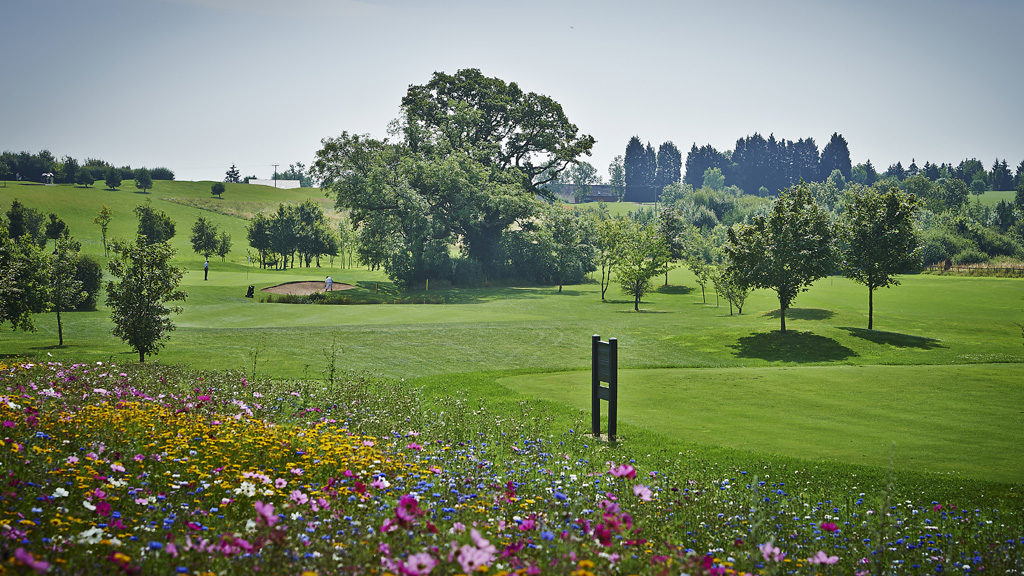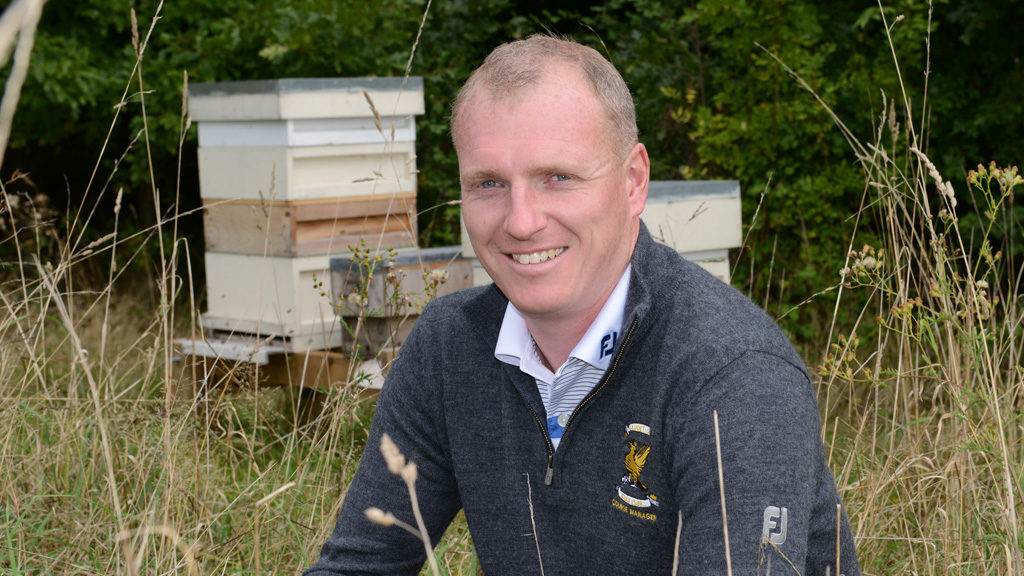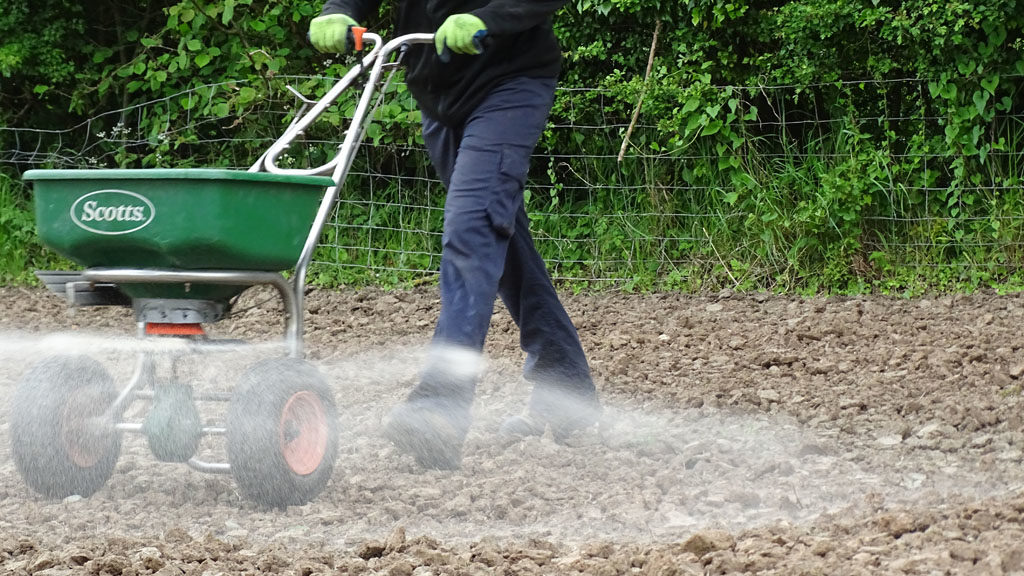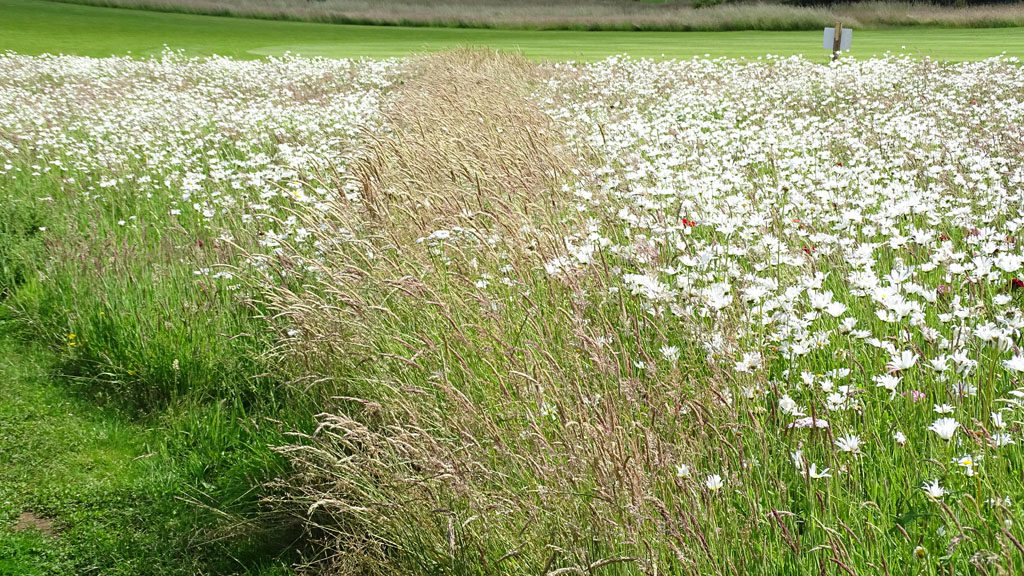WILDFLOWERS BRING GAUDET LUCE TO LIFE

Gaudet Luce Golf Club is alive and thriving – not only with the many golfers and other visitors to its facilities, but also with the wildlife it has been actively managing to attract to the course.
Operating near Droitwich in the West Midlands there is plenty of competition for prospective players, but the welcoming ethos for both its visitors and its ecology is making a real difference, reports Course Manager, Andy Laing (above).
“We are always looking for something else that gives Gaudet Luce an edge, and a reason for golfers to keep coming back,” said Andy. The course has a very healthy membership of around 1000 players - utilising the various flexible options on offer - and has diversified buildings and facilities to develop an attractive business community, but is still keen to build-up society days and visiting golfers to maintain the economic viability.
“Greens quality and course condition remains our number one priority, followed by tees and approaches that keep the focus on getting things right for golf,” highlighted Andy. “Environmental areas may be third on the list, but they are still and important part of creating an attractive place to come and play.”
Constructed just 21 years ago, Andy’s environmental habitat creation has been instrumental in making a far more mature impression. Extensive tree planting, involving some 50,000 trees, has already produced a framework that both surrounds the course to shield it from its urban and M5 motorway neighbours, as well as defining the internal flow of fairways and holes.

Whilst the tree planting canopy provides shape, it’s the use of environmental rough that comes into its own to separate holes and give a greater feeling of space and isolation. “We are fortunate to have the space to develop areas that are effectively out of play to all but the most wayward shots, but can still have a real visual and ecological impact,” enthused Andy.
The course now has a dozen areas planted up with a mix of wildflowers that successfully adds interest and colour for players, as well as a vital ecological resource for pollinating insects and an increasing variety of wildlife.
It has not been all plain sailing for Andy’s ecological initiatives at Gaudet Luce. Initial efforts to establish perennial wildflower habitats proved largely unsuccessful, with most of the sown species slow to establish and swamped beneath coarse grasses – which can still predominate as a legacy of the former agricultural fields.

“It was early in the days of wildflower habitat creation, and whilst we did cut and remove the grasses for a couple of seasons, we didn’t have the experience or tools to manage it effectively,” recalled Andy. But, even after several years, close inspection shows that some of the original plantings have survived and there may be the chance to revive the habitats by spraying off a trial patch the coarse grasses with Rescue in the spring, and possibly supplementing the sward with fresh wildflower seed.
Annual addition
After the disappointment with the expensive perennial mixes, Andy decided to try an annual wildflower mix that promised to be easier to establish and quicker to generate a visible effect. The result was indeed incredibly colourful, but with limited species of primarily traditionally garden wildflowers.
“It was very encouraging that we could get a result, and that we could reliably repeat it each year,” reported Andy. “However, we really wanted something that was more naturalistic and in keeping with the parkland golf surroundings."
“After trying a couple of different commercially available pure annual wildflower mixes, we began to find the areas were becoming quickly overtaken by undesirable weeds and not delivering the desirable flower flush,” he added. “Furthermore, the flowering was short duration and not providing the prolonged source of pollen and nectar so important to bees and other pollinating species.”
To resolve that, Andy has moved to a biannual mix, which provides a greater diversity of species, which are predominantly naturalistic flowers and give a summer-long flowering that extends intro autumn and beyond. “As we reliably get two years of flowering from each sowing, we have effectively halved the time and cost of establishment, and yet still deliver a really attractive result.”
Establishment tips
However, Andy emphasised that care and attention over the establishment is essential to achieve early flowering in the first year, and for the mix to successfully work through to the second season. The schedule that has worked for them has been to spray off the areas with glyphosate in March or April; leave for two to three weeks to die back and then rotovate a good seedbed; leave for a further two weeks to trigger a further flush of weeds; spray again with glyphosate and the seed onto a fine surface.

The fine seed is mixed with sand to bulk up for sowing, with the seed spun onto the fine surface. In some instances a drag harrow has been used and, depending on the conditions, the area rolled to improve seed to soil surface contact and retain moisture.
“We do find that it’s important to wait for the soils to warm up, so that germinations is rapid and the seedlings can get quickly established,” he advised. “For us the spring seeding fits in better with the workload, compared to autumn when we would be busy with renovation and course maintenance.”
To look after the biannual mix, he has found that a light topping in the late autumn, after flowering has finished, can be beneficial.

Last year he also found that when one area was being overshadowed by coarse grasses going into its second season, an application of Rescue suppressed the grasses and allowed the wildflowers to proliferate; one pass left unsprayed (above, centre) demonstrated the effect - with virtually no flowers visible, whilst the treated area was full of colour and life.
“Using Rescue is another tool that can help us to manage ecological rough more effectively and consistently get the best effect for our site, and clearly,” Andy added.
“We are also looking at how it might fulfil another primary objective to enhance course appearance and playability, by removing selective patches of invasive coarse ryegrass on some of the fairways and tiger rough.”
Environmental attraction
Gaudet Luce Managing Director, Martin Fernihaugh, has recognised the importance of encouraging and diversifying the ecology of the course, as both an attraction for the club and to promote a positive story for the golf industry as a whole.
“Whilst we do have a proportion of players or whom the golf is everything, there is a far larger contingent of the membership where the welcome in the clubhouse, the company of fellow members and the environment around the course are equally important to their enjoyment of the game,” reported Martin.
“It has been a real revelation to dismiss the perception that golf courses are a ‘green desert’,” he said. “In fact, we now have a wider diversity of plants, insects and birds than when the course was farmland."
“We have clearly demonstrated that managing a golf course and enhancing the environment is entirely compatible, and that Gaudet Luce is providing a valuable ecological resource to the area,” Martin added.
Syngenta Operation Pollinator gives greenkeepers and golf course managers the tools and techniques to successfully and cost effectively establish and manage attractive wildflower resources.
“Environmental enhancement of relatively undisturbed out of play areas can provide the perfect location for immensely valuable ecological habitats,” said Caroline Carroll, Syngenta Operation Pollinator Manager. “With the right management, designated areas can provide ideal habitat for a vast array of vital pollinating insects, as well as enhancing the visual appeal and overall enjoyment for players,” she added.
Biannual seed mix composition favoured at Gaudet Luce: Source: Limagrain | |
White Yarrow Large Green Basil Mixed California Poppy Mixed Double Barbeau Cornflower Single Red Poppy Queen of May Chrysanthemum Aegean Wallflower Silvercup Mont Blanc Lavertera | Red Flax Perennial Blue Flax Pixie Delight Dwarf lupine Mixed Simple Sweet Williams Calendula Pacific Beauty Mixed Thiaspi Umbellata Viper Bugloss |
